MARKET OVERVIEW
The Global Ro Membranes market is one of the most critical sectors in the overall water purification and treatment industries, catering to the emerging demand for clean and pure water across various applications. RO membranes are the key element of this market. They form the basis upon which the separation of contaminant and impurities can be made from water. These membranes are precisely designed to allow water molecules to pass through while filtering out dissolved salts, microorganisms, and other particles, thus being crucial for both residential and industrial water purification processes.
This market covers applications in desalination, wastewater treatment, and process water purification for industries in pharmaceuticals, food and beverage, power generation, and electronics manufacturing. The increasing reliance on reverse osmosis technology has demonstrated efficiency, cost-effectiveness, and the ability to meet stringent water quality standards. Challenges of water scarcity will be on the rise as populations grow and urbanize; therefore, the demand for effective water treatment solutions is bound to increase. The Global Ro Membranes market will act as a major facilitator in overcoming these challenges to ensure access to potable and process-ready water.
The market is geographically quite diversified, with demand arising not only from developed economies but also from emerging economies. Developed and emerging economies will further be characterized by high acute water shortages in the regions of the Middle East and North Africa and some portions of Asia-Pacific. Water scarcity in these regions requires desalination, as RO membranes are considered good for this process. Conversely, in developed regions such as North America and Europe, the emphasis is on modernizing the water infrastructure and following tight environmental regulations. This is a global scope that underlines the universal applicability of RO membrane technology to address water-related issues.
Technological innovation will define the course of Global Ro Membranes market in the coming years. Ongoing improvements in membrane materials will likely make thin-film composites and nanotechnology-enriched membranes more effective at filtration, more robust, and resistant to fouling. These innovations would cater to the demand for greener and energy-conserving solutions. Integration of smart monitoring systems and predictive maintenance technologies into RO set-ups will likely increase the operational efficiency of the solution and promote its usage even further in different industries.
The dynamic nature of the market is also being driven by growing environmental sustainability awareness. Many industries are increasingly adopting RO membranes as part of their strategy to reduce wastewater discharge and recycle water. This aligns with global efforts in reducing water footprints and achieving long-term environmental goals. As industries continue to focus on eco-friendly practices, the Global Ro Membranes market is likely to expand its significance in promoting sustainable water management.
The Global Ro Membranes market represents an essential segment of the water treatment industry, poised to address critical water challenges through technological innovation and expanding applications. Its importance will continue to grow as global water scarcity issues intensify and industries increasingly demand efficient and sustainable water treatment solutions. With its broad scope and evolving capabilities, this market will remain at the forefront of global efforts to ensure water security for future generations.
Global Ro Membranes market is estimated to reach $7,717.37 Million by 2031; growing at a CAGR of 9.6% from 2024 to 2031.
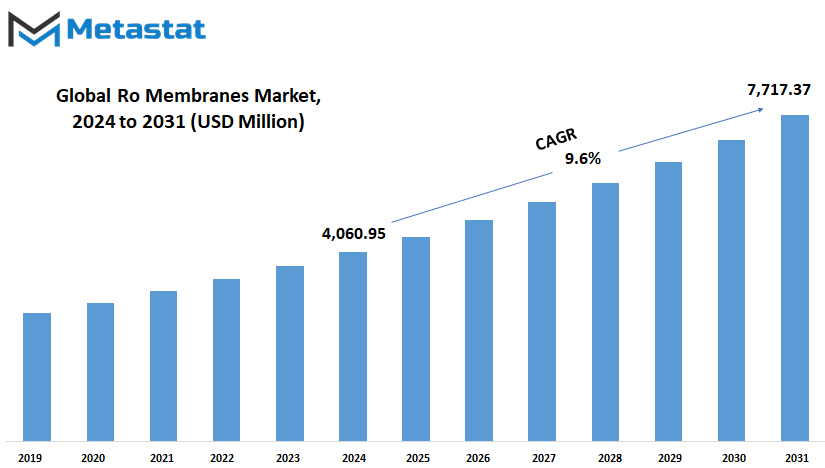
GROWTH FACTORS
The global RO membranes market is seeing a massive momentum due to the growth in demand for clean, safe drinking water. It is the outcome of an increased pressure on water resources due to rapid urbanization and population growth. Reverse osmosis membranes, therefore, have gained attention because they filter impurities properly and deliver pure water, which is safe for human consumption. Beyond residential applications, these membranes are increasingly being adopted in industrial and commercial water treatment processes, further boosting their market demand.
Industries and businesses rely heavily on efficient water treatment systems, and RO technology has proven to be a reliable solution for removing contaminants, improving water quality, and meeting stringent regulatory standards. This widespread adoption underlines the pivotal role of RO membranes in supporting water sustainability efforts across various sectors. However, the market poses challenges and could hamper its progression. High-energy consumption together with the operations costs still present major inhibitors for adopting RO systems hence less reach to the required users while membrane fouling and scaling issues still determine efficiency requiring frequent maintenance work that prove costly and quite time consuming.
Despite all those challenges; the future about the outlook of the worldwide RO membrane market is expected to smile. Advancements in material science and manufacturing processes open the door for energy-efficient and durable membranes. This research is working to eliminate current drawbacks like high power demands and fouling sensitivity to improve overall performance and cost-effectiveness of RO systems. Emerging needs for desalination and wastewater treatment solutions, especially in regions faced with severe water scarcity, are expected to drive further innovation and investment in the technology.
Sustainability focus, coupled with recognition of water as a critical resource, is likely to propel continued advances in the RO membranes market. As governments and organizations emphasize water conservation and management, the demand for effective and long-lasting water treatment solutions will increase. It presents a significant opportunity for market players to introduce high-end products that cater to the changing needs of environmental and industrial requirements. The global RO membranes market is well-positioned to play a crucial role in shaping the future of water treatment and sustainability through the challenges and harnessing of the potential of technological progress.
MARKET SEGMENTATION
by Type
The growth in water treatment technologies along with the rising need for clean and sustainable water solutions has been driving the global market of RO Membranes. Water purification is impossible without the use of reverse osmosis (RO) membranes as they help remove various impurities, salts, etc. These membranes are quite significant for industries, municipalities, and households interested in finding effective methods to ensure water quality.
The market is divided into type as Thin-Film Composite Membranes, Cellulose-Based Membranes, Polyamide Membranes, and Others. Thin-Film Composite Membranes hold the largest share, valued at approximately USD 2,431.52 million. This is because they exhibit excellent performance in desalination and wastewater treatment, making them the most preferred across industries. Cellulose-Based Membranes are the second in line, valued at USD 805.10 million. These membranes are relatively inexpensive and biodegradable, targeting clients who want to save money without sacrificing efficiency. Polyamide Membranes are valued at USD 624.15 million and remain in popular demand due to their great filtration accuracy and durability that makes them fit for intricate industrial applications. The combined value of other types accounts for USD 200.18 million, which is comprised of niche options suited for unique applications.
As the global population increases, the demand for safe water will rise, and that will further propel the demand for RO membranes. Environmental concerns and regulation measures to reduce industrial water pollution are encouraging industries to adopt advanced filtration technologies. Hence, the Global RO Membranes market is expected to gain from increased investments in research and development, which may lead to more efficient membrane solutions at lower costs.
More inroads of technology are on the cards for the future. Nanotechnology and artificial intelligence will help improve performance by minimizing cost and maximizing life. Highly water-scarce geographies will also become one of the most significant markets going forward, where RO membrane shall find greater use in the desalination projects that create a significant market opportunity for manufacturers to offer more solutions to customers.
In conclusion, the Global RO Membranes market has strong growth prospects, driven by technological advancement and water conservation awareness. The developments in action and future innovations promise a dynamic shift toward sustainable and efficient water treatment solutions in meeting the global demand for clean and accessible water resources.
By Configuration
The Global RO Membranes market is on the rise due to increased improvement in water treatment technology and the growing demand for clean, potable water around the world. Therefore, Reverse Osmosis (RO) membranes find a significant place in reducing water scarcity and contamination concerns and thus become crucial to the industrial, municipal, and residential sectors. Due to the increasing water problems, the development and utilization of RO membranes are increasing with time, which, in turn, provide efficient filtration and purification solutions to the world.
In comparison to the options provided by market configurations, several selections meet specific needs. The most commonly used is the spiral wound membrane. The spiral wound design offers an effective configuration that makes removal of dissolved salts and impurities more efficient. Spiral-wound membranes are applied primarily for industrial-scale treatment in applications where space is crucial and performance is highly critical. Hollow fiber membranes offer a great degree of versatility for different water qualities to be treated. They can filter at high flux rates with unique structure, making them preferred in municipal water treatment and desalination projects.
Plate and frame membranes provide a different advantage, easy maintenance and customization. The modular design allows operators to change the filtration process according to specific requirements, making it highly versatile. These membranes are often used in niche applications, such as food and beverage processing, where precise filtration is required. Tubular membranes also find niche applications, where they are used for the treatment of highly viscous or contaminated water. Their robust construction ensures durability in challenging conditions, often seen in industrial wastewater management.
Going forward, the Global RO Membranes market will continue to grow with more investments from industries and governments in sustainable water treatment solutions. Innovations in membrane technology, such as greater energy efficiency and increased durability, will propel the industry. As climate change affects the availability of water, demand for advanced filtration systems will increase, which in turn will increase the use of RO membranes.
With these results, the future of the Global RO Membranes market seems to be more innovation and adaptation. Each type—spiral wound, hollow fiber, plate and frame, and tubular membranes—has its advantages suited for individual needs. This can increase the importance of access to safe and clean water when needed most by technologies used in providing a surety of reliable and clean sources of water to serve, which makes the demand increase with time as a constantly changing world dictates it to be so.
By Application
The Global RO Membranes market is likely to grow due to the growing demand in different sectors for effective water treatment solutions. Reverse osmosis (RO) membranes are emerging as a source of critical technology for accessible clean and safe water at a time when water is increasingly scarce for many countries. As important as they are, there also exist these membranes with some sort of efficiency in filtering water from impurities and pollutants for the proper handling of most of the problems about quality. This market, extending to desalination applications, utility water treatment processes, wastewater treatment and subsequent reuse, and finally processing water applications, creates excellent opportunities for innovation and for expansion.
One of the major applications of RO membranes is in areas that are suffering from acute shortages of water supply. Since it converts seawater into potable water, desalination presents a more sustainable solution to meet increasing population and industrial demands. With the ongoing technological progress in improving the efficiency of RO membranes, the sector of desalination would continue to grow steadily, hence ensuring supply of water to regions facing limited freshwater supplies.
RO membranes are gaining tremendous ground in utility water treatment. It has been adopted by municipalities and public utilities as a reliable technology to deliver safe drinking water to communities. Its use in this sector is increasingly on the rise, as regulatory pressures on the quality of water are rising and as it reduces heavy metals and harmful chemicals from the water. As urbanization and industrialization expand, the demand for advanced water treatment solutions will likely grow further, thereby boosting the potential of the market.
RO membranes are one of the sustainable solutions that can mitigate environmental issues and water scarcity for wastewater treatment and reuse applications. Industries and municipalities are likely to minimize their impact on the environment while making sure that they have an adequate supply of water in the future through the use of recycled treated wastewater in non-potable applications.
Process water applications also form a very significant part of the Global RO Membranes market. The pharmaceutical, food and beverage, and electronics industries all require high-purity water for their operations. This makes RO membranes a necessity. As industries demand ever higher quality standards, reliance on this technology is expected to increase, which would open up opportunities for innovation and market growth.
The Global RO Membranes market is going to change and find solutions to some of the most critical water-related issues facing modern society with increasing environmental awareness, technological advancements, and growing demand in various sectors.
By End-Use Industry
The global RO (Reverse Osmosis) membranes market is expected to witness tremendous growth as the access to clean water gains priority for industries and households alike. Reverse osmosis technology has been the most effective technique for the purification of water, solving the problems of large-scale industrial requirements and individual household usage. This market is segmented on the basis of end-use industries: water and wastewater treatment, industrial processing, and residential or point-of-use (PoU) water treatment. Each segment is expected to be highly influential in driving the future of this market.
The demand for RO membranes in the water and wastewater treatment sector is projected to increase with increased intensification of global water scarcity issues. Governments and other organizations worldwide are spending much on sophisticated water treatment plants in both urban and rural centers to cater to the rising demands for clean water. RO membranes play a significant role in these facilities as they effectively remove impurities, salts, and contaminants. With increasingly stringent environmental regulations, industries and municipalities are forced to adopt reliable water treatment technologies, thereby further increasing demand for these membranes.
Industrial processing is the other major segment driving the growth of the global RO membranes market. Industries such as food and beverage, pharmaceuticals, and power generation require purified water for their operations. RO membranes are a reliable and cost-effective means of producing water that meets stringent quality standards. Moreover, due to technological advancements, newer RO membranes are becoming energy-efficient and durable, making them a preferred choice for industries looking to reduce operational costs while adhering to environmental guidelines.
Adoption of RO membranes in residential applications is rising as people get more aware of the quality of the water they are drinking. Point-of-use water treatment systems, utilizing RO membranes, are getting popular for providing safe drinking water at home. It is also expected to move upward with an increase in urbanization and health awareness.
Looking forward, innovation in membrane technology will support the global RO membranes market. Such advancements are going to improve performance and sustainability. Current challenges such as energy consumption and membrane fouling will be addressed with the help of these improvements. Water scarcity and pollution remain significant issues, and so will the adoption of RO technology across various sectors. Hence, this market will continue to gain importance in shaping a sustainable and water-secure future.
|
Forecast Period |
2024-2031 |
|
Market Size in 2024 |
$4,060.95 million |
|
Market Size by 2031 |
$7,717.37 Million |
|
Growth Rate from 2024 to 2031 |
9.6% |
|
Base Year |
2022 |
|
Regions Covered |
North America, Europe, Asia-Pacific Green, South America, Middle East & Africa |
REGIONAL ANALYSIS
The Global RO Membranes market is one of the pivotal components in water purification technology, with huge growth across different regions. Geographical presence is found in the regions of North America, Europe, Asia-Pacific, South America, and the Middle East & Africa. Contribution towards the region and future outcomes are essential for its growth factor in the market.
The role of countries such as the U.S., Canada, and Mexico will be highly pivotal in North America due to their advancement in water treatment systems. The United States, with investments in its water management infrastructure and industrial applications, leads in this region. Canada, in its initiatives to maintain sustainable usage of water, stands close behind, while modern technologies applied to address Mexico's scarcity add to its influence in this region. This collective progress is reflective of North America's focus on innovation and efficiency in water purification.
Europe, which includes countries such as the UK, Germany, France, and Italy, also plays an important role in the Global RO Membranes market. Germany is at the forefront of adopting efficient membrane systems because of its emphasis on environmental protection and technological advancements. Similarly, France and Italy are improving their infrastructure to solve water quality issues. Such efforts reflect the proactive position of Europe in solving water-related challenges while aligning with environmental goals.
Asia-Pacific, consisting of India, China, Japan, and South Korea, is emerging as the hub. With rapid urbanization and industrialization, demand for water treatment solutions in the region is increasing. In particular, China, an emerging industrial hub, has gone ahead with RO Membrane technology on a large scale, and India, being aware of its expanding population with concerns over water scarcity, is implementing sustainable water management strategies. Japan and South Korea will be emphasizing technological innovation, focusing on efficiency, to secure a position for this region at the center of expansion.
South America, including Brazil and Argentina, is slowly emerging within the market. On-site water resources in abundance will boost demand in the wake of increasing purification in Brazilian needs, while Argentina focuses much on modernizing its infrastructural facilities for water treatments will add to the probability levels in South America to ensure improvement in water quality issues as well.
Middle East & Africa is also a promising contributor to the market through countries such as Egypt and South Africa, as well as the GCC. Being in arid climates and limited in water resources, RO Membranes are the sole savior for this region for the availability of fresh water. Innovative solutions based on specific requirements make the Middle East & Africa a prime region for the growth trajectory of the Global RO Membranes market. This integrated regional analysis highlights global support for sustainable water purification technologies as they develop and meet future requirements.
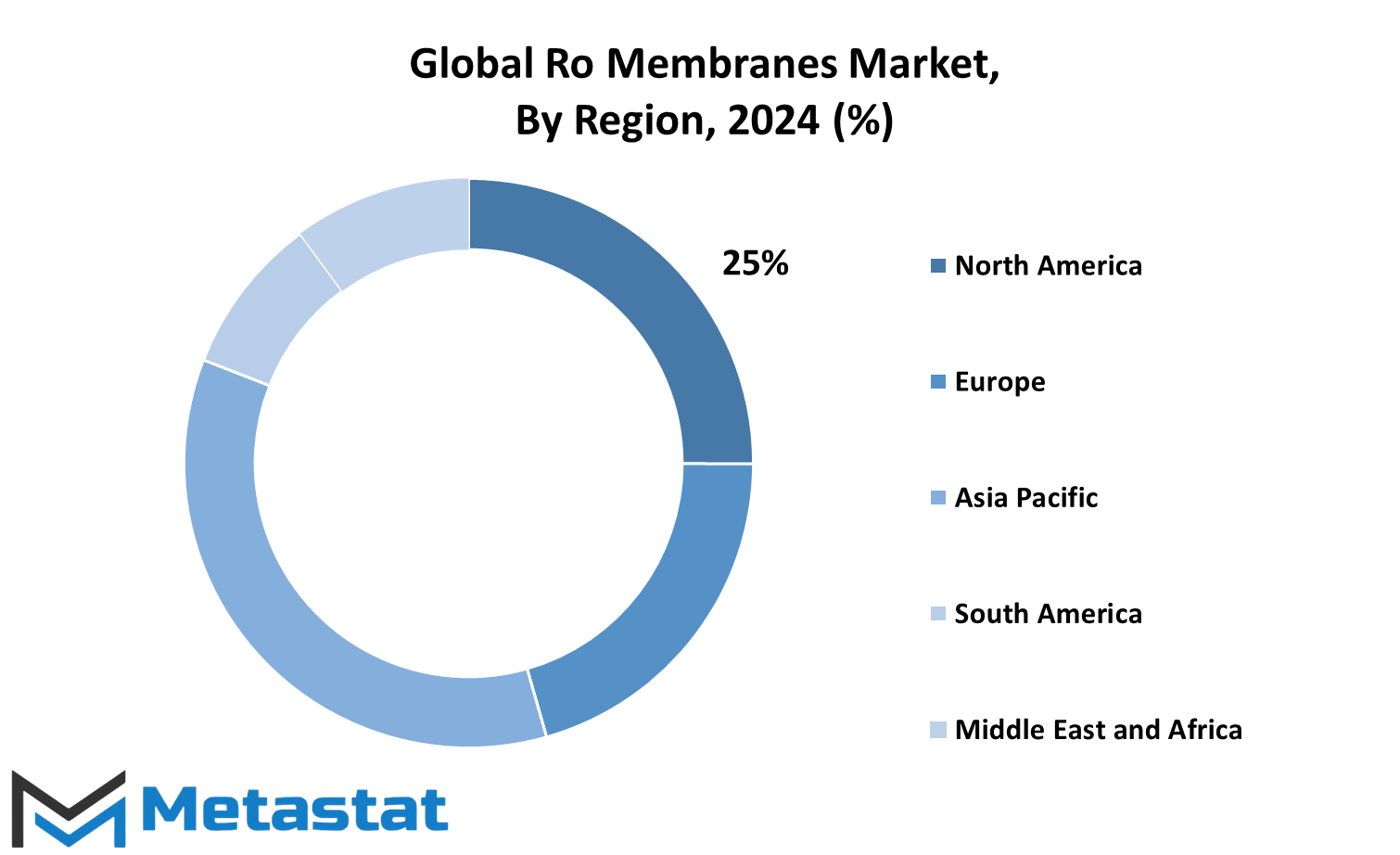
COMPETITIVE PLAYERS
The global Reverse Osmosis (RO) membranes market represents an important part of the water treatment and filtration industry, fueled by growing concerns over worldwide water scarcity and quality. Critical players in the market contribute to the developments and meet the growing demand for sustainable and efficient water filtration solutions. These companies are always innovating new technologies with respect to the needs and demands of various industries, including the residential, commercial, and industrial sectors. They focus both on the improvement of performance by RO membranes and reducing the operational cost in a more environmentally sustainable way.
Market leaders in this field are constantly striving through innovation in technology and strategy through collaboration. In such a light, investment in research and development is what has driven the ability of these firms to bring out membranes with greater durability, improved efficiency in filtration, and resistant fouling. The advent of membranes, which have been made operational under pressure conditions and withstand different types of water compositions, is another area that has proven highly beneficial in building the case of major players in this market.
The competitive landscape is highly rivalrous as companies seek to expand their reach across the emerging markets. As there is a growing demand for clean water solutions in those regions facing water scarcity, players are customizing products to meet local needs. Many companies are also moving towards eco-friendly manufacturing processes as consumers increasingly look at sustainable products. These efforts are part and parcel of global efforts whose aim is to minimize any environmental damage that might result while affording everyone safe and adequate water.
Moreover, leading firms are increasingly entering into joint ventures and mergers through which they can combine both resources and expertise. Hence, these companies can find solutions to complex issues much more effectively and also keep up with the diverse expectation of customers. These moves are also facilitating rapid innovations and providing solutions that do not only work effectively but also reach a larger extent of people.
Into the future, the global RO membrane market will continue to innovate through technology and increasing interest and care towards water conservation. For such a scenario, there remain some competitive players at the fore of this evolution; that being pushed from innovating with what fits within future trends and will overcome challenges. Their innovation would be critical in effectively answering the demand for safe, clean, and healthy waters for the benefit of businesses around the globe and communities.
Ro Membranes Market Key Segments:
By Type
- Thin-Film Composite Membranes
- Cellulose Based Membranes
- Polyamide Membranes
- Others
By Configuration
- Spiral Wound Membranes
- Hollow Fiber Membranes
- Plate and Frame Membranes
- Tubular Membranes
By Application
- Desalination
- Utility Water Treatment
- Wastewater Treatment & Reuse
- Process Water
By End-Use Industry
- Water & Wastewater Treatment
- Industrial Processing
- Residential/Point of Use (PoU) Water Treatment
Key Global Ro Membranes Industry Players
- Alfa Laval
- Axeon Water Technologies
- BNKO Environmental Technology (Shanghai) Co., Ltd.
- Dupont
- Freudenberg Filtration Technologies GmbH & Co. KG
- Ion Exchange India Ltd (Hydramem)
- Hydranautics
- Hunan Keensen Technology Co.,Ltd.
- Kovalus Separation Solutions, Inc.
- LG Chem
- Lenntech B.V.
- Membranium
- MANN+HUMMEL Water & Fluid Solutions GmbH
- Parker Hannifin Corporation
- Permionics Membranes Private Limited
WHAT REPORT PROVIDES
- Full in-depth analysis of the parent Industry
- Important changes in market and its dynamics
- Segmentation details of the market
- Former, on-going, and projected market analysis in terms of volume and value
- Assessment of niche industry developments
- Market share analysis
- Key strategies of major players
- Emerging segments and regional growth potential



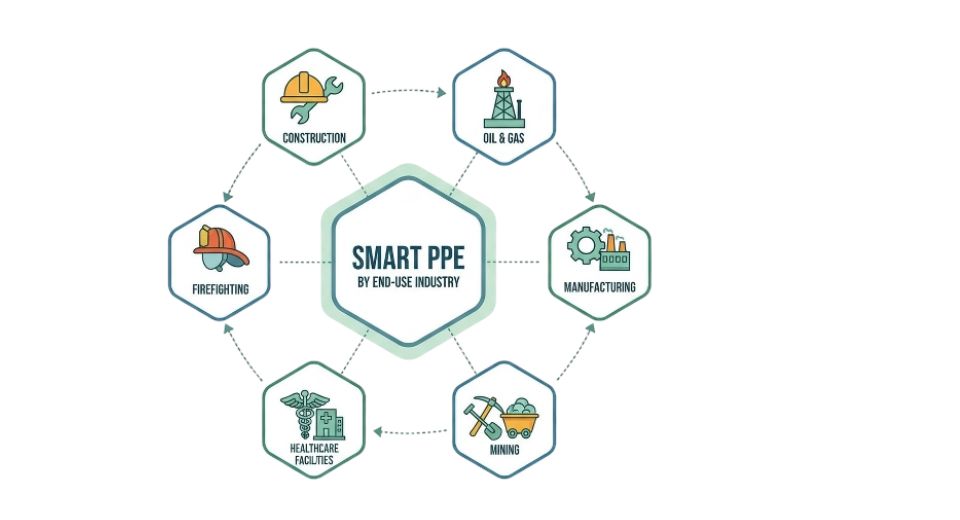
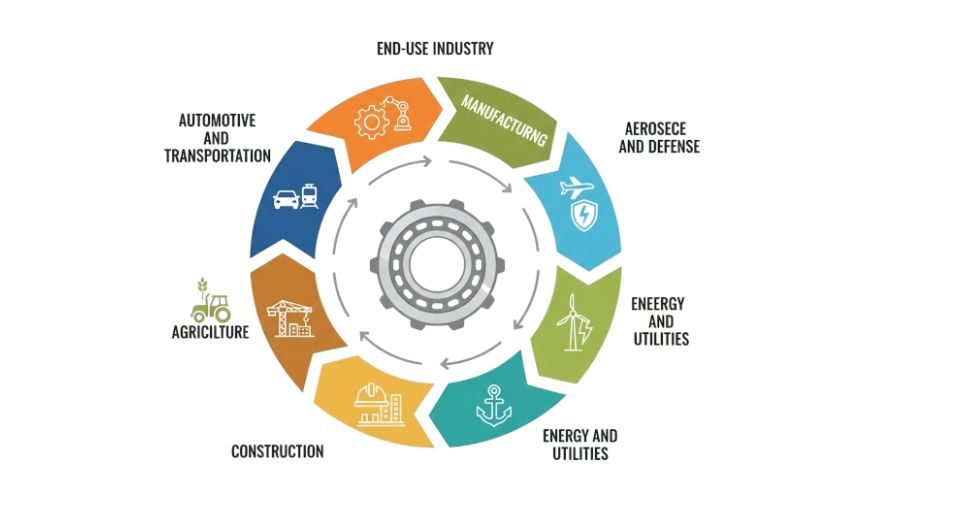
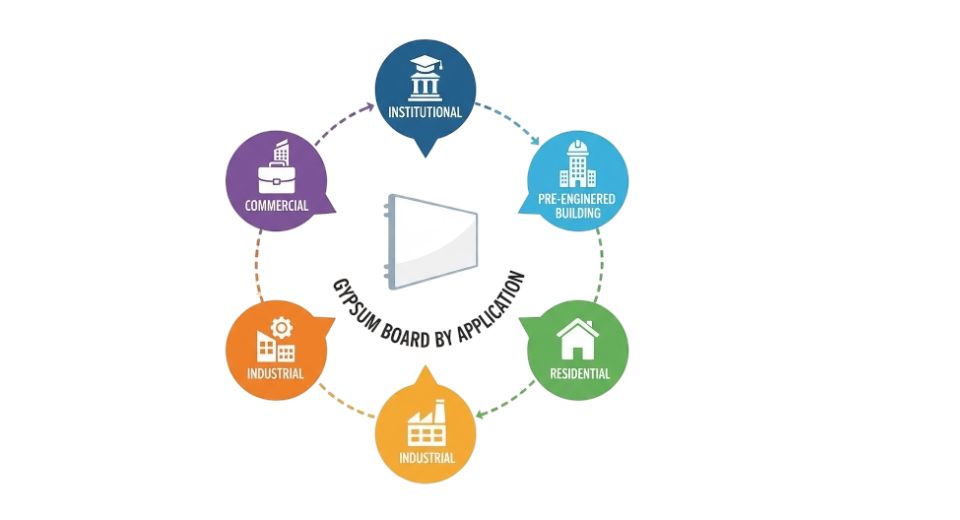
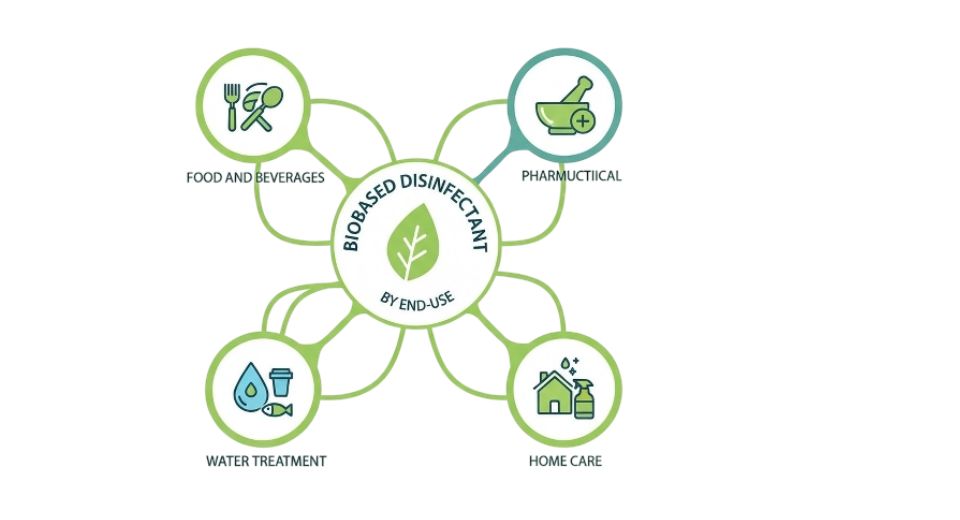

 US: +1 3023308252
US: +1 3023308252






